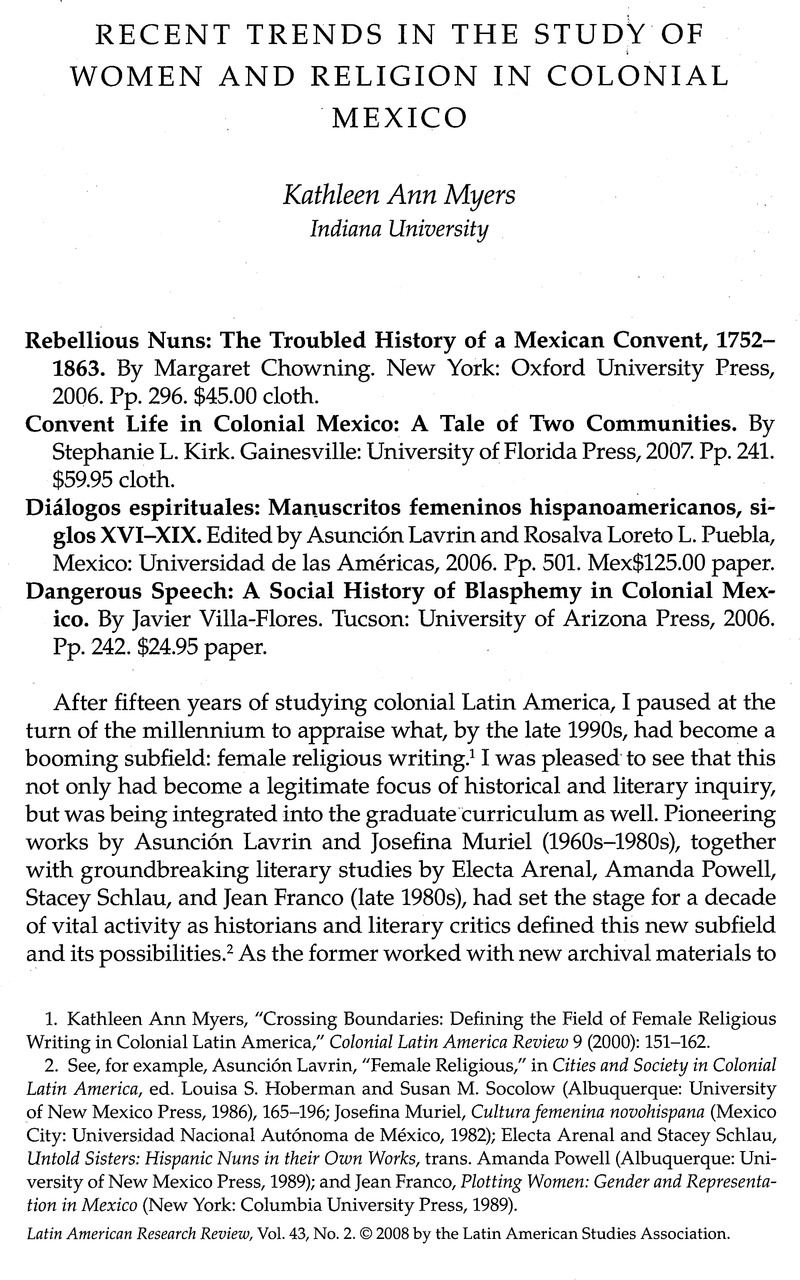Article contents
Recent Trends in the Study of Women and Religion in Colonial Mexico
Review products
Published online by Cambridge University Press: 05 September 2022
Abstract

- Type
- Review Essays
- Information
- Copyright
- Copyright © 2008 by the University of Texas Press
References
1. Kathleen Ann Myers, “Crossing Boundaries: Defining the Field of Female Religious Writing in Colonial Latin America,” Colonial Latin America Review 9 (2000): 151–162.
2. See, for example, Asunción Lavrin, “Female Religious,” in Cities and Society in Colonial Latin America, ed. Louisa S. Hoberman and Susan M. Socolow (Albuquerque: University of New Mexico Press, 1986), 165–196; Josefina Muriel, Cultura femenina novohispana (Mexico City: Universidad Nacional Autónoma de México, 1982); Electa Arenal and Stacey Schlau, Untold Sisters: Hispanic Nuns in their Own Works, trans. Amanda Powell (Albuquerque: University of New Mexico Press, 1989); and Jean Franco, Plotting Women: Gender and Representation in Mexico (New York: Columbia University Press, 1989).
3. In 2004–05 alone there was an explosion of materials published, including Isabel Arena Frutos, Dos arzobispos de México ante la reforma conventual femenina (1766–1775) (León, Mexico: Universidad de León, 2004); Jennifer Eich, The Other Mexican Muse: Sor María Ana Agueda de San Ignacio (New Orleans: University Press of the South, 2004); Ellen Gunnarsdottir, Mexican Karismata: The Baroque Vocation of Francisca de los Ángeles, 1674–1744 (Lincoln: University of Nebraska Press, 2004); Jacqueline Holler, “Escogidas Plantas”: Nuns and Beatas in Mexico City, 1531–1601 (New York: Columbia University Press, 2005); Juan Ricardo Jiménez Gómez, ed., Creencias y prácticas religiosas en Querétaro, siglos XVI–XIX (Querétaro, Mexico: Universidad Autónoma de Querétaro, 2004); Alicia Mayer and Ernesto de la Torre Villar, eds., Religión, poder y autoridad en la Nueva España (Mexico City: Universidad Nacional Autónoma de México, 2004); Frank Graziano, The Wounds of Love: The Mystical Marriage of Rose of Lima (Oxford: Oxford University Press, 2004); Nancy E. Van Deusen, The Souls of Purgatory: The Spiritual Diary of a Seventeenth-Century Afro-Peruvian Mystic, Ursula de Jesús (Albuquerque: University of New Mexico Press, 2004); Nora Jaffary, False Mystics: Deviant Orthodoxy in Colonial Mexico (Lincoln: University of Nebraska Press, 2004); and Rosalva Loreto, ed., Una empresa divina: Las hijas de Santa Teresa de Jesús en América (1604–2004) (Puebla, Mexico: Universidad de las Américas, 2004). For Sor Juana studies, see Frederick Luciani, Literary Self-Fashioning in Sor Juana Inés de la Cruz (Lewisburg, PA: Bucknell University Press, 2004); Rosa Perelmulter Pérez, Los límites de la femeneidad en Sor Juana Inés de la Cruz: Estrategias retóricas y recepción literaria (Madrid: Iberoamericana, 2004); and Grady Wray, The Devotional Exercises/Los ejercicios devotos of Sor Juana Inés de la Cruz, Mexico's Prodigious Nun: A Critical Study and Bilingual Annotated Edition (Lewiston, NY: Edward Mellen Press, 2005).
4. Several other recently published books are worthy of review, including Antonio Rubial García, Profestisas y solitarios: Espacios y mensajes de una religión dirigida por ermitaños y beatas laicos en las ciudades de Nueva España (Mexico City: Universidad Nacional Autónoma de México, 2006); and Susan Schroeder and Stafford Poole, eds., Religion in New Spain (Albuquerque: University of New Mexico Press, 2007).
5. As I note in my previous study, “Crossing Boundaries” (158), groundbreaking anthologies such as those by Arenal and Schlau and Muriel often incorrectly represent the words of male biographers as the speech of the women about whom they write.
6. Margo Glantz, Sor Juana Inés de la Cruz: Hagiografía o autobiografía (Mexico City: Grijalbo, 1995); Stephanie Merrim, Early Modern Women's Writing and Sor Juana Inés de la Cruz (Nashville, TN: Vanderbilt University Press, 1999); and Alison Weber, Teresa of Ávila and the Rhetoric of Femininity (Princeton, NJ: Princeton University Press, 1990).
7. Asunción Lavrin, “Ecclesiastical Reform of Nunneries in New Spain in the Eighteenth Century,” The Americas 22 (1965): 182–203; Kathryn Joy McKnight, The Mystic of Tunja: The Writings of Madre Castillo (Amherst: University of Massachusetts Press, 1997); Kathleen Ann Ross, The Baroque Narrative of Carlos de Siguenza y Góngora: A New World Paradise (New York: Cambridge University Press, 1993).
8. Solange Alberro, Inquisición y sociedad en Mexico, 1571–1700 (Mexico City: Fondo de Cultura Económica, 1988); Kathryn Joy McKnight, “Blasphemy as Resistance. An African Slave Woman before the Mexico Inquisition,” in Women in the Inquisition. Spain and the New World, ed. Mary E. Giles (Baltimore: Johns Hopkins University Press, 1999), 229–253.
9. Susan Migden Socolow, “Colonial Gender History,” Latin American Research Review 40 (2005): 265.
10. Lisa Vollendorf, “Recent Trends in Gender Studies: Early Modern Spain and Colonial Latin America,” Gender & History 18 (2006): 416.
11. Kellen Kee McIntyre and Richard E. Phillips, eds., Woman and Art in Early Modern Latin America (Boston: Brill, 2007), 3.
12. For example, Asunción Lavrin, “Women in Spanish American Colonial Society,” The Cambridge History of Latin America, vol. 2, ed. Leslie Bethell (Cambridge: Cambridge University Press, 1984), 321–349.
13. Mario J. Valdés and Djelal Kadir, eds., Literary Cultures of Latin America: A Comparative History, vol. I (New York: Oxford University Press, 2004); Rosemary Skinner Keller and Rosemary Radford Ruether, eds., Encyclopedia of Women and Religion in North America, vol. 1 (Bloomington: Indiana University Press, 2006); and Isabel Morant Deusa, ed., Historia de las mujeres en España y América Latina (Madrid: Cátedra, 2005–06), vol. 1. Another example is the Oxford Encyclopedia of Women in World History, ed. Bonnie Smith (New York: Oxford University Press, forthcoming).
14. Alison Weber, ed., Approaches to Teaching Teresa of Ávila and the Spanish Mystics (New York: Modern Language Association of America, forthcoming); Emilie L. Bergmann and Stacey Schlau, eds. Approaches to Teaching Sor Juana Inés de la Cruz (New York: Modern Language Association of America, forthcoming).
- 2
- Cited by


